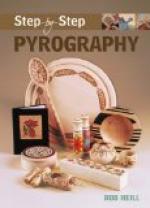“An unfaithful mason’s like a broken tooth or a foot out of joint,” observed the Scot when he saw some haphazard masonry he was to replace with proper stonework. “That wall’s a bit o’ baith.”
David would take all the pains in the world with a well-meaning but slow workman, but he disposed of shirkers and double-dealers without needless words. Neither did he encourage discussion and idle talk about the work.
“A true mason’s no sae glib-gabbet,” he observed one day. “There’s no need o’ speechmaking to make an adder bite or a gude man work.”
David confirmed Mother Izan’s opinion of the virtues of Solomon’s Seal. The Turks, he said, used to eat the young shoots, cooked. The children already knew that Solomon was the Grand Worshipful Master of all the masons of the world. About his majestic and mystical figure centered legends and traditions innumerable. Solomon’s Knot was a curious intricate combination of curving lines. Solomon’s signet was a stone of magical virtues. The temple of Solomon was the most wonderful building ever seen, and the secrets of its masonry were still treasured by master masons everywhere. No sound of building was heard within its walls; the stones were so perfectly cut and fitted that they slid into their places without noise. And Solomon himself was the wisest man who ever lived. He could understand the talk of the martins under the eaves, the mice in the meal-tub and the beasts of burden in the stables, when they conversed among themselves.
“Aiblins that’s what gar’d him grow sae unco wise,” David ended. “You bear in mind, Master Roger, that every leevin’ thing ye see, frae baukie-bird tae blackfish, kens some bit cantrip he doesna tell, and ye’ll be a Solomon—if ye live.”
David was eating his bread and cheese on the lee side of the wall when Eleanor came by with a gray lump of clay in her hands.
“See what Gwillym has made,” she said.
David stopped with the cheese half way to his mouth. “Who’s Gwillym?” he asked.
“He’s a boy we’ve known ever since he was very little—he’s only eight now—and he does make the most alive looking things out of clay. He heard you telling about Solomon talking with the birds and beasts, and he made this.”
The clay group was really an unusual piece of modelling for an untrained hand. That a child should have made it was more than remarkable. The thin bent figure of the wise King was seated on a throne formed of gnarled tree-roots. On his wrist a raven perched; on his shoulder crouched a squirrel, with tail alert for flight; two rabbits sat upright at his feet; a lamb huddled against his knee on one side and a goat on the other. The figures all had a curiously lifelike appearance. As Eleanor said, one felt that if they heard a noise they would go away. Moreover she saw with wonder that the head of King Solomon and his lifted hand made him a fair portrait of David.




